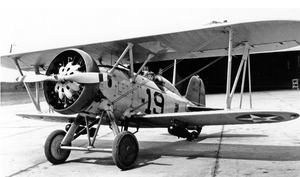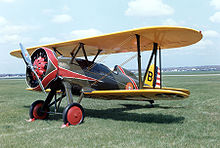Boeing P-12
| Boeing P-12 | |
|---|---|

|
|
| Type: | Biplane fighter |
| Design country: | |
| Manufacturer: | |
| First flight: |
June 25, 1928 |
| Commissioning: |
1930 |
| Production time: |
1929 to 1932 |
| Number of pieces: |
366 |

The Boeing P-12 was a biplane fighter aircraft produced by the American manufacturer Boeing .
The model, which was delivered to the United States Army Air Corps (USAAC) as an army aircraft and a naval version to the US Navy between 1929 and 1932, was the standard fighter of these two branches of the armed forces between the two world wars and, due to the high numbers delivered, also a commercial one Success for the Boeing company.
The machine was the last biplane fighter in the USA; Some machines were in use there until 1941, and machines delivered to Thailand are said to have been in service there until 1949.
construction
The Boeing P-12 was a single-engine, single-handled biplane with different wingspan of the two wings with the same profile depth. The fuselage consisted of a fabric-covered (in later versions planked with aluminum) tubular steel frame construction, the supporting structure was a fabric-covered wooden construction. The two-wheeled main landing gear, which was connected to the fuselage in different ways depending on the version, was unclad with a - depending on the type - rigid or steerable tail spur, in one variant also with a tail spur wheel. The marine versions were usually equipped with a catch hook .
development
After Boeing was able to deliver the F2B to the US Navy in 1925 , the company was hoping for a follow-up order for the successor model. At the beginning of 1928, Boeing manufactured two pre-series machines at its own expense - first flight on June 25, 1928 - and delivered them to the Navy in the hope that the tests there of the machines that were then known in-house as Model 83 would result in an order for a corresponding number of these single-seat fighter aircraft; It was also hoped that the new model could replace the now outdated PW-9 machines in the US Army (the planned Army version was initially referred to in-house as Model 89). In the military, both machines, which differed in details due to the different operating conditions in the different branches of arms, were designated as XF4B-1. The naval version was also tested by the army aviators.
The two types differed in the design of the landing gear; the marine version was also equipped with a catch hook for use on aircraft carriers, while the army version had a device for carrying a 249 kg bomb. Boeing's philosophy in this further development was unusual. Contrary to the usual practice of equipping a new model with a more up-to-date and more powerful engine, it was hoped that in this case an increase in performance compared to the PW-9 and the F2B would only be achieved by improving the airframe when using the Pratt & Whitney which has proven itself in the previous models. Wasp Motors.
The tests at the Navy led to the demand for a machine that corresponded to the Model 89 with a catch hook, and initially brought Boeing a production order from the Navy for 27 machines - designated as F4B-1. Within 4 months of the maiden flight, all 27 machines ordered were delivered, and these planes formed the basis for a multitude of variants commonly known as the Boeing P-12. The first aircraft to be delivered took off on February 26, 1929 with Captain Ira Eaker at the wheel for a commercial flight to Central America.
variants
(the first designation is the Boeing-internal model designation, the designation in brackets corresponds to the type designation of the armed forces)
Model 99 (F4B-1A)
Single piece; Retrofitting of a machine from the original F4B1 series for a senior US Navy employee
Model 100
Designation for four civil aircraft corresponding to the F4B-1 series, which were manufactured by Boeing for export
Model 101A
Single piece; two-seater made for US billionaire Howard Hughes
Model 100E
two machines similar to Model 234 (see below), delivered to Thailand / Royal Thai Air Force
Model 100F
a machine, delivered to Pratt & Whitney for engine tests (similar to model 251 see below)
Model 101 (XP-12A)
modified model 102; the modifications related to changed ailerons and elevators, a changed landing gear, a swiveling tail skid and a NACA engine cover
Model 102 (P-12)
This is the name of the first nine of a total of 10 machines ordered by the US Army, which were ordered from Boeing after the successful tests. This type largely corresponded to the test sample of the Model 89 series (XF4B-1).
Model 102B (P-12B)
This version corresponded to the Model 101 series with improved ailerons and elevators; 90 machines of this type were procured by the US Army.
XP-12G
A single piece from the P-12B series (see above) was briefly equipped for test purposes by the US Army with a Pratt & Whitney R1340 radial engine with turbocharger, but later restored to the standard.
Model 218
The Model 218 was a one-off from Boeing, built with a fuselage in half-shell construction. The machine was briefly made available to the US Army for testing as a model for Model 234 and was later sold to China. There it was lost in a dogfight with three Japanese aircraft after its pilot was able to shoot down two of his opponents.
Model 222 (P-12C)
improved model 102B with streamlined engine cowling, with a landing gear similar to the original model 83; 131 machines of this series were ordered by the US Army, 95 (according to another source 96) machines were delivered (remainder as Model 227)
Model 223 (F4B-2)
48 machines of the marine version of the Model 222 (with tail wheel)
Model 227 (P-12D)
remaining 36 machines of the Model 222 delivery; the change in the type designation resulted from minor detail changes
XP-12H
a copy of the Model 227 series, which was temporarily equipped with a different engine and was later reduced to P-12D standard
Model 234 (P-12E)
135 machines of this type were ordered by the US Army, 110 copies were produced by Boeing, the rest were delivered as Model 251 with different engines
Model 235 (F4B-3 or F4B-4)
21 copies of the Model 235 series were used by the Navy as F4B-3; the machines corresponded in principle to the P-12E of the Army; Another 92 pieces of this model received a larger vertical stabilizer and were designated by the Navy as F4B-4.
A folded inflatable boat was integrated into the headrests of the last 45 machines in this series.
Model 251 (P-12F)
the last 25 machines of the Model 234 series delivered, equipped with a Pratt & Whitney SR-1340 of a newer generation, which had the advantage of delivering better performance than its predecessor at high altitudes
Model 256
14 machines delivered to Brazil (design corresponded to the F4B-4, but without catch hook for use as a land plane)
Model 267
Pattern also for Brazil; this type, of which 14 were delivered, had the supporting structure of the P-12E, otherwise the machine corresponded to the F4B-3
P-12J
Designation for seven machines with F-2 turbochargers converted from the P-12E, the time of the conversion is not known, nor is there any information about whether a later dismantling may have taken place.
It should also be noted that some P-12s that were originally delivered to the US Army were handed over to the Navy in 1940, where they were designated as F4B-4A.
Between 1929 and 1931, Boeing produced 586 machines of this type family, 366 of which were delivered to the US armed forces. In addition to the USA, Brazil and China, it was also used in Spain.
P-12 in museums
- a P-12E machine is now in the National Museum of the United States Air Force , Dayton, Ohio
- a P-12 in the National Air and Space Museum of the Smithsonian Institution in Washington DC issued
- a marine-grade machine, an F4B-4, has also survived and is on display in the National Museum of Naval Aviation at Naval Air Station Pensacola Florida
- one of the two machines delivered to Thailand can be seen in the Royal Thai Air Force Museum
Technical specifications
| Parameter | Data (P-12E) |
|---|---|
| crew | 1 |
| length | 6.19 m |
| span | 9.14 m |
| height | 2.74 m |
| engine | Pratt & Whitney R- 1340-17, 373 kW (507 hp) |
| Top speed | 304 km / h |
| Marching speed | 257 km / h |
| Range | 917 km |
| Max. Takeoff mass | 1220 kg |
| Armament | two 7.62 mm MG or one 7.62 and one 12.7 mm MG. Plus bombs (111 kg each) |
Web links
Individual evidence
- ↑ P-12 / F4B Fighter. In: History. Boeing, 2019, accessed November 1, 2019 .
